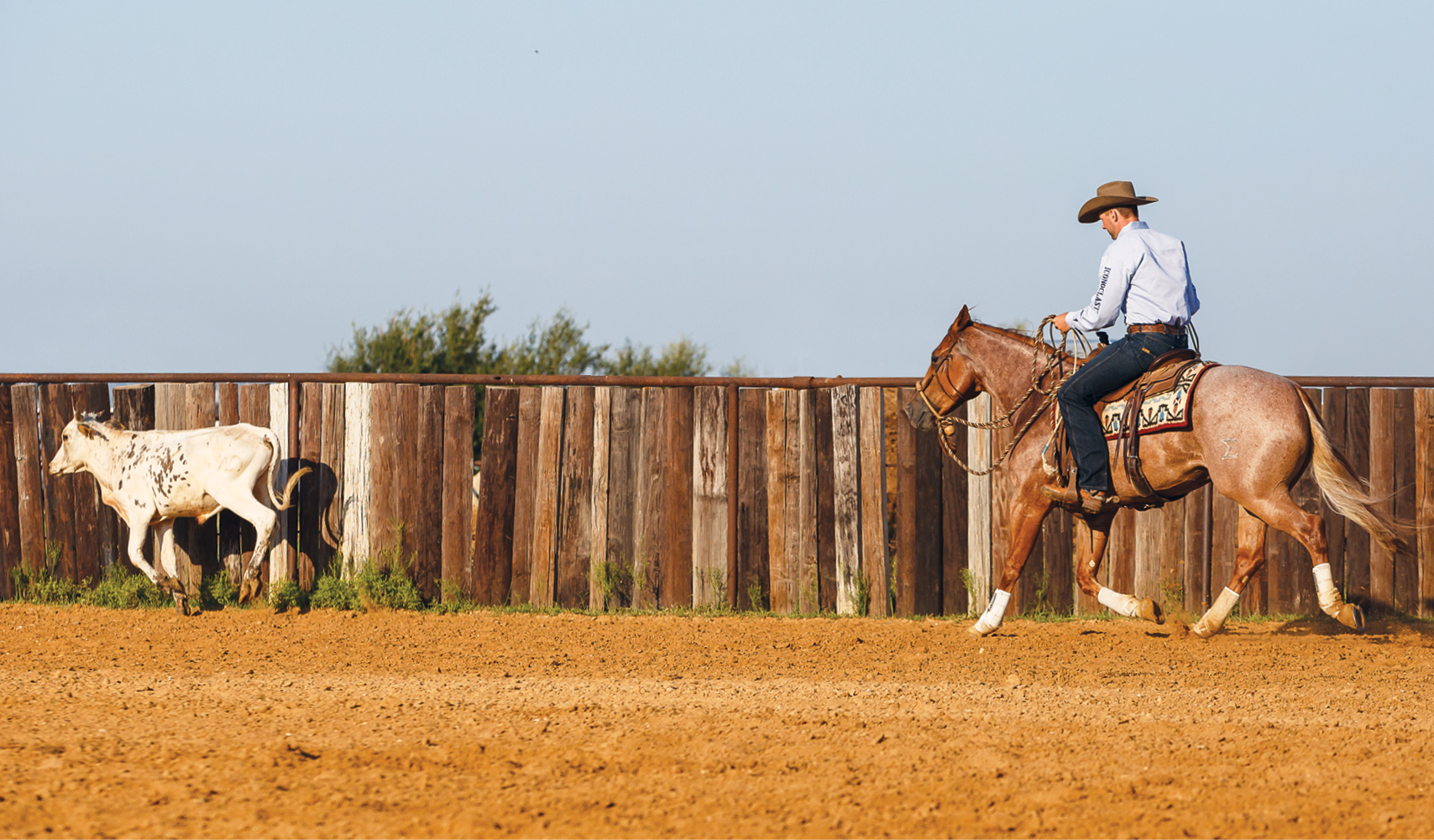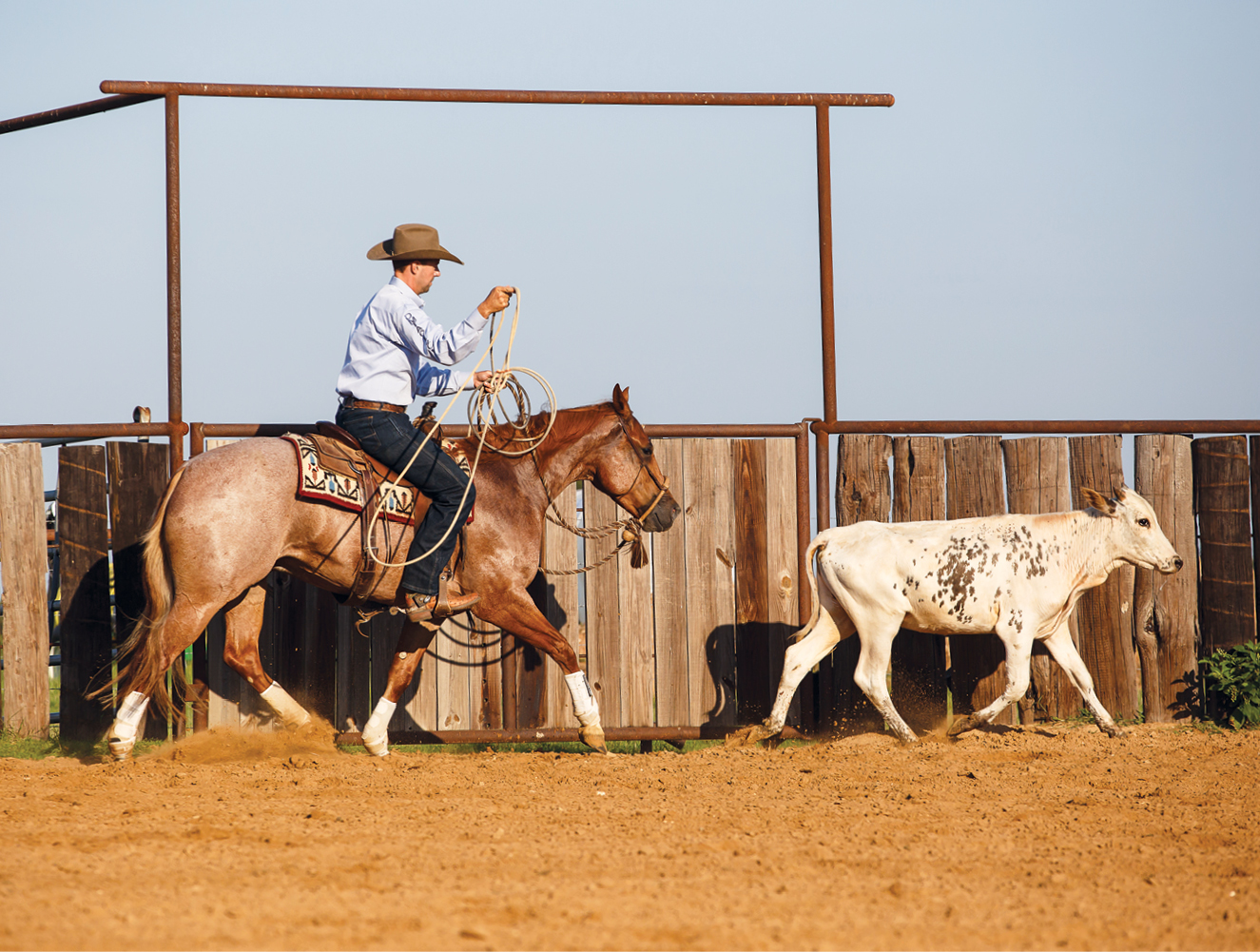Even if you don’t compete in events like cutting or working cow horse, or have a horse that was bred to do cow work, including cattle work into your riding routine can be a great training tool for you to have. While exposure to cattle is always necessary if you plan on showing in an event that uses cattle, outside of the show ring, working your horse around cattle can help him become well-rounded and ready to tackle anything that comes his way when you’re trail riding.
However, before you head off to work a cow, here’s some advice that’ll make the experience most beneficial for you and your horse.
Why Cattle Work is Helpful
Riding your horse around cattle is a great way to evaluate how he reacts when you up the degree of difficulty during training. It also helps you know which maneuvers you need to work on the next time you ride. For example, in a class like reining a horse has to be able to go from a large, fast circle to a small, slow circle. Working a cow helps you evaluate how well your horse rates his speed in a scenario where you have to go from one speed to another within one stride. If your horse doesn’t slow when you ask for the initial cue, you can spend more time at home reinforcing your shut-down cue. Another thing to test is how responsive your horse is to leg and hand cues.
It can also help freshen up a dull horse. At any point in the arena, your horse has to be ready to go and needs to have purpose behind what he’s doing—he can’t just lope around the arena and hope he’ll keep up with a cow.
[RELATED: WHAT TO KNOW BEFORE BRINGING CATTLE TO YOUR BARN]

Even if you never plan to compete in an event where cattle will be present, the opportunity for your horse to focus on another animal, say like when you’re working on cutting one cow from the herd and holding it away from the herd, gives him the chance to be soft and be quicker in his decision-making.
Adding cattle to your training routine is also great for you as a rider. If you’re new to working with cattle, you have to learn how to read them, see where their bubbles are, and be able to think on your feet and adjust your plan at any moment.
You can learn something new about your horse, as well. I’ve had horses that were supposed to be reiners, and just didn’t have the ability to go past a certain level of competition, end up making great versatility ranch horses or working cow horses. I found that when I shifted their focus to cow work, they were much happier than when I was trying to prepare them for reining events.
Necessary Skills
In cow work, you’re trying to hold a cow away from the herd. To keep it from the herd, you need to have a quick stop and a quick turnaround on your horse; something you’ll need to practice beforehand. You should be able to sit down, release your legs, pick your hand up, and have him stop on his hind end without any hesitation. If there’s a delay in your stop or your turn, the chance of you losing a cow goes up.
If you notice your horse isn’t stopping and turning as quickly as he should, take him off the cow and work on those maneuvers. Don’t go back on the cow until you’re happy with how he’s stopping and turning, so your horse continues to have a positive outlook with working cattle.

Equipment
Any time you get on a horse, you must always pay close attention to your equipment to ensure it’s in good, working condition—while it’s always dangerous if your tack comes apart while you’re riding, it can be especially dangerous when adding a cow to the equation.
For bit selection, I recommend starting in a smooth snaffle. Once you’re riding, pay attention to how your horse responds in the snaffle. You can always adjust to a different bit if needed. However, if you find yourself running into problems where your horse is going too fast or not respecting your cues, take him off the cow immediately and go back to working basics in whatever bridle you’re most comfortable riding him in. Safety is extremely important, and you should only put your horse on a cow when you’re in total control and in a safe environment.
It’s not necessary to put protective leg gear on your horse every time you go to ride. If you know you’re going to do strenuous work—with or without cattle—it’s always a good idea to have leg protection. But if you’re lightly exercising your horse at home, like moving cattle from one pasture to another at a walk, sometimes it’s good to go without leg gear to help him gain strength in his tendons and improve bone density.
Safety First
If you’ve never been around cattle before, it’s very important to ride with an experienced rider or have a professional there to facilitate your horse’s introduction to cattle, to ensure everyone stays safe. Some horses take longer to desensitize to cattle, and it’s beneficial to have someone there who can help you safely introduce your horse to cattle.

While I recommend riding your horse around cattle regardless of the discipline you compete in, if you’re serious about getting into events that require cattle, I highly recommend finding a professional in your area who can be of assistance and help you prepare to show.
[RELATED: DESENSITIZE YOUR HORSE TO CATTLE]
Getting the freshness out of your horse before introducing him to cattle will help him keep his mind focused on the cow. If you haven’t ridden your horse in a couple of weeks, and you go to put him on a cow without a really good warmup, the extra stimulation of a cow could push him to the edge of behaviors such as bucking, running, playing, or rearing.
For the first introduction, try introducing your horse to the cow at the end of your ride. You’ve already done your work, and he’s tired. That’s going to help set you up for success and make being around a cow less exciting for him.
Different Ways to Work Cattle
Driving. This is a natural starting point if you have just one cow to work. With the cow loose in the arena, position your horse behind it, and work on driving it around. This helps your horse (and you!) learn how to read cattle and teaches him how to respond to the cow’s movements as you push it around the arena in different directions.
The main goal is to watch the cow’s body language and become more responsive when it starts to go in a different direction. A general rule of thumb is, the closer you get to the cow, the faster it’s going to move. Start around 50 feet away so your horse has plenty of time to see it and get comfortable with it being in the arena before getting closer.

An easy way to think about driving a cow around an arena is to imagine working your horse on the ground in a round pen. While you’re driving the cow around, if you position your horse behind the cow’s shoulder, you ask it to move forward. If you point your horse’s head to the cow’s hip, that cow should feel pressure on its hindquarters and walk forward. You can’t drive the cow forward if you’re standing in front of it. If you step up in front of the cow’s shoulder and put your horse parallel with the cow, you’re going to encourage it to stop and turn.
Boxing. This is a popular class at ranch versatility events, but the basic moves can be helpful for your horse to learn regardless on if you show. The overall goal is to keep the cow on the short end of the arena and mirror its movements—not allowing it to go down the long side of the arena at any point.
To do this, step your horse up beside the cow, and have your leg in line with the cow’s head to encourage it to stop and turn rather than continue forward. When the cow stops and turns, you will too. Stay parallel with the cow, and follow its movements as it goes back and forth. This demonstrates control over the cow.
You’ll quickly learn that every cow has a different feel. Some cattle are very sensitive, and as soon as you get in front of their shoulder, they stop and go the opposite direction. Others can be dull, and you might have to get all the way in front of it and even cut it off to get it to turn.
Tracking. This skill is particularly useful for events like roping. I track and rope off all my young horses and use a breakaway rope. You want your horse’s nose almost at the cow’s hip, driving it around. Your horse should be locked in on following the cow’s movements regardless of what your hand is doing, because you’ll soon be occupied with swinging a rope.
This drill teaches your horse to take responsibility for tracking the cow and staying on the cow’s hip until you ask for a stop.

